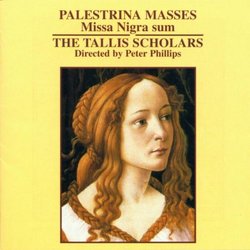| All Artists: Gregorian Chant, Jean Lheritier, Giovanni Pierluigi da Palestrina, Tomas Luis de Victoria, Andreas de Silva Title: Palestrina: Missa Nigra sum Members Wishing: 0 Total Copies: 0 Label: Gimell UK Release Date: 2/12/2002 Album Type: Import, Original recording reissued Genres: Special Interest, Classical Styles: Opera & Classical Vocal, Historical Periods, Early Music Number of Discs: 1 SwapaCD Credits: 1 UPC: 755138100329 |
Search - Gregorian Chant, Jean Lheritier, Giovanni Pierluigi da Palestrina :: Palestrina: Missa Nigra sum
 | Gregorian Chant, Jean Lheritier, Giovanni Pierluigi da Palestrina Palestrina: Missa Nigra sum Genres: Special Interest, Classical
|
Larger Image |
CD Details |
CD ReviewsA voice teacher and early music fan George Peabody | Planet Earth | 05/13/2009 (5 out of 5 stars) "ANOTHER ENGAGING, ENTERTAINING, BUT MOST OF ALL INFORMATIVE RECORDING FROM PETER PHILLIPS AND THOSE TERRIFIC TALLIS SCHOLARS!
The line-up on this recording is as follows: The Plainchant 'NIGRA SUM' is followed by a motet of the same name from Jean L'heritier(c.1480-after 1552). Ir is based on the same melody, and then follows a parody Mass by Palestrina, based on the L'heritier motet. The album concludes with motets by Tomas Luis de Victoria and Andreas de Silva that are also based on the same Plainchant melody. (SUGGESTION to the listener: at this point it would be prudent to read the above paragraph again just so you have a picture of how this music is put together.) The text for the Plainchant "NIGRA SUM, SED FORMOSA" (I am black, but comely), combines three Marian antiphons-'Nigra sum, Iam hiems transiit and Speciosa facta es -sung now at Second Vespers for the common Feasts of the Virgin; with the Alleluia placed at the end of each antiphon; the plainchant is proper to the Easter period, L'heritier's music has much of the balance that is associated with Palestrina; the points unfold slowly and spaciously, and the part-writing is sonorous. The principal difference is that L'heritier wrote counterpoint throughout, whereas Palestrina added homophony to his general technique. L'heritier actually joins Josquin's style to Palestrina's by developing the technique of using imitation consistently. Palestrina was much impressed by L'heritier's technique of presenting nicely balanced arches predominently in step-wise motion, and Palestrina's music shows this influence. L'heritier's motet "NIGRA SUM" on this disc is his five-part version; he has also composed four and six-part versions. The motet and Palestrina's (1525-1594)"MISSA NIGRA SUM" is scored for soprano, countertenor, two tenors and bass. It's important to note that this Mass has no musical connection with Palestrina's own motet 'Nigra Sum', and therefore is not included on this recording. Instead of Palestrina's poise, Tomas luis de Victoria (1548-1611) leans more toward the words and therefore his motet "NIGRA SUM" has a strong pictorial feel. Andreas de Silva's (1475/80-1530) motet "NIGRA SUM", though short,is sonorous and has a straightforward, almost declamatory style. This recording has one of the best line-up of Tallis Scholars that I have ever heard: Jane Armstrong, Alison Gough,Deborah Roberts, Emily van Evera(sopranos); Michael Chance, David Cordier (countertenors); Joseph Cornwall, Andrew King, Rufus Muller, Andrew Murgatroyd (tenors) and Francis Steele, Julian Walker (basses). It was recorded in 1983 in the Mertin College and is an excellent example of the Tallis Scholar's innovative programing. And, moreover, it is hauntingly beautiful. The early Gimell recordings are hard to beat overall. " |

 Track Listings (9) - Disc #1
Track Listings (9) - Disc #1